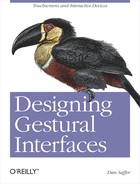Colophon
The animal on the cover of Designing Gestural Interfaces is a channel-billed toucan (Ramphastos vitellinus). Found in Trinidad and tropical areas of South America, the channel-billed toucan makes its home in moist lowland forests and woodlands. It shares the bright plumage and large bill (approximately 3.5–5.5 inches) common to other toucan species. Scientists are unsure from an evolutionary standpoint why the bill is so large, but the toucans make good use of it for scooping up water, fencing with one another, and snipping fruit off trees. They prefer very ripe, whole fruits, and eventually pass or regurgitate the seeds, making the birds vital for seed dispersion in the rain forest. Aside from fruit, their diet occasionally consists of eggs, baby birds, snakes, spiders, and lizards, which provide a good source of protein.
Channel-billed toucans lay their eggs in tree cavities high off the ground. Both parents play an active role, taking turns incubating for 15–16 days and feeding the newborns when the eggs hatch. Newborn toucans stay in the nest and are quite helpless for the first several weeks of their life; their eyes remain closed for the first three weeks, they don't develop feathers for almost a month, and they have special pads on their feet to protect them from the nest's rough floor. They begin to leave the nest after 40–50 days.
If pulled from their nests and hand-fed as babies, toucans can eventually make pets, albeit high-maintenance ones. They're quite active and must have a large enough cage to accommodate them, as well as plenty of toys to stave off boredom. Their high-fruit diet can be expensive, not to mention messy, since toucans are notorious fruit flingers.
The cover image is from the Dover Pictorial Archive. The cover font is Adobe ITC Garamond. The text and heading font is Myriad Pro.
